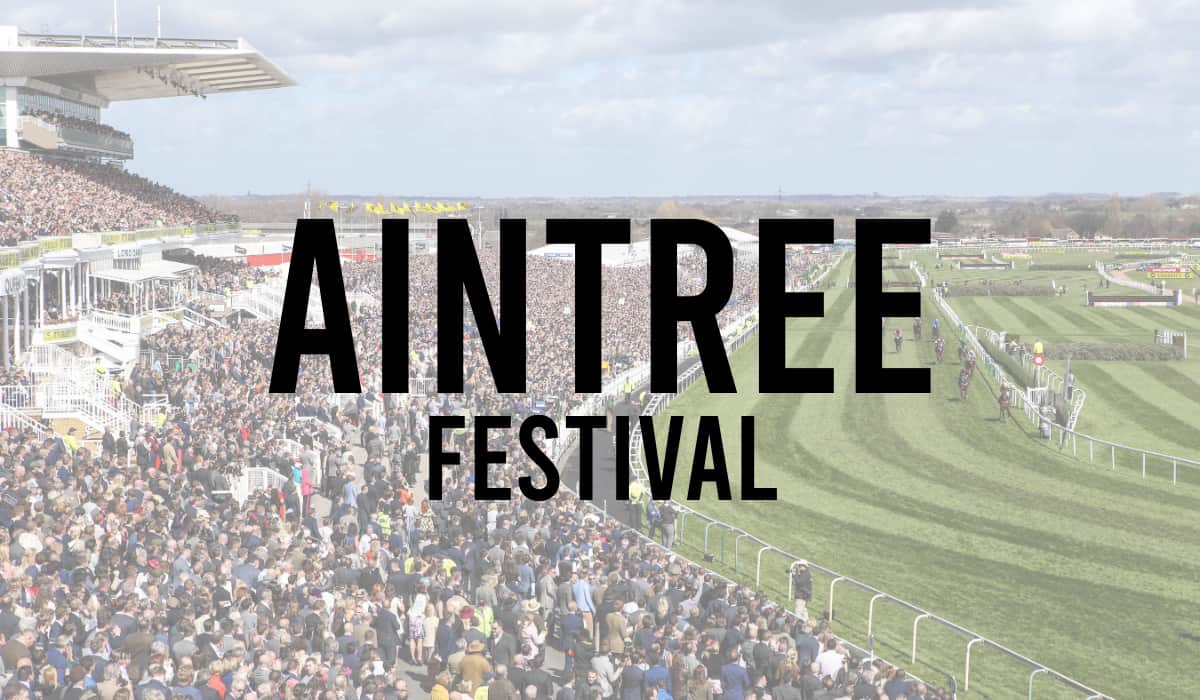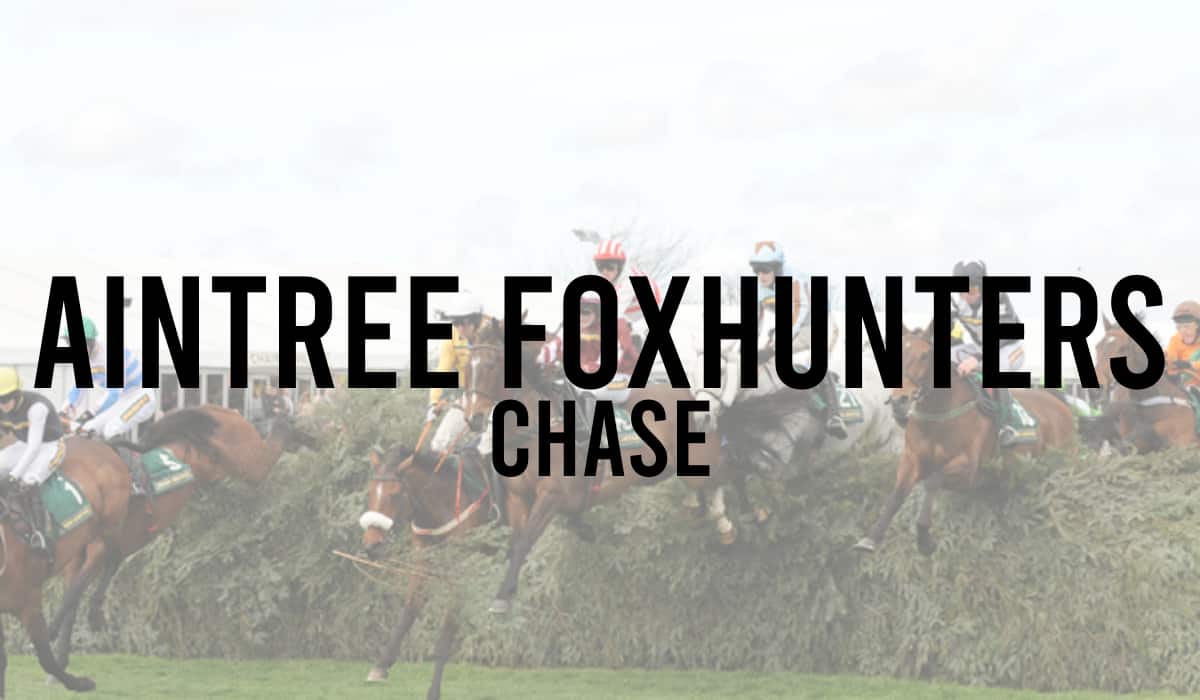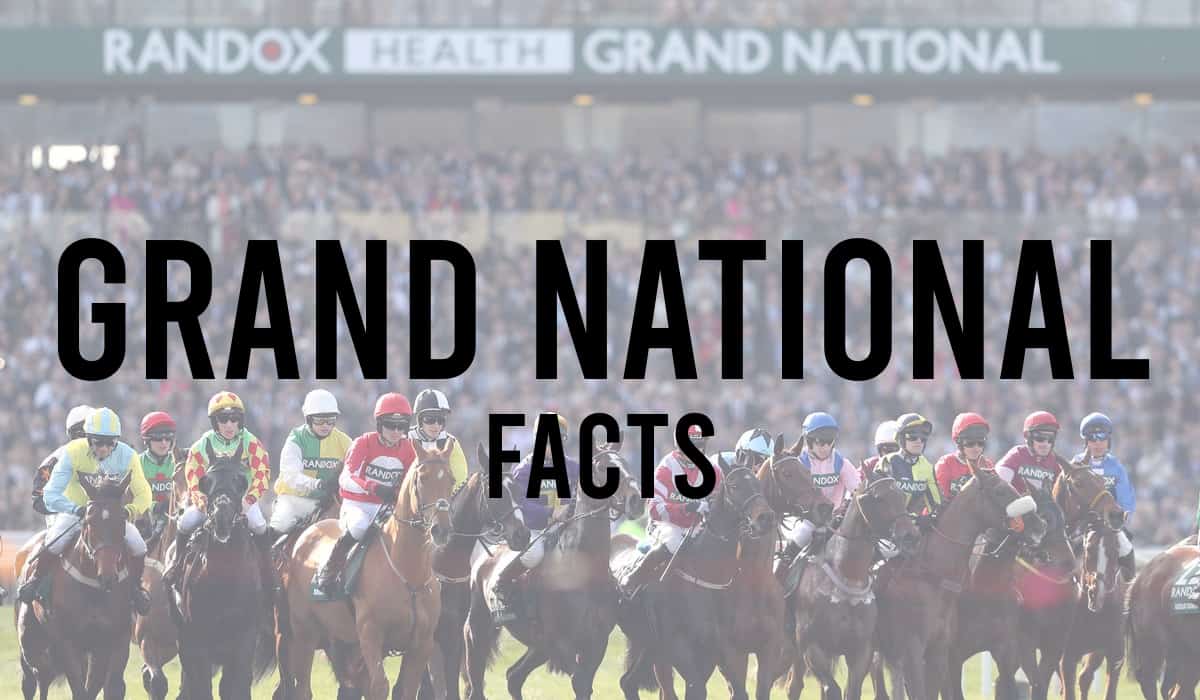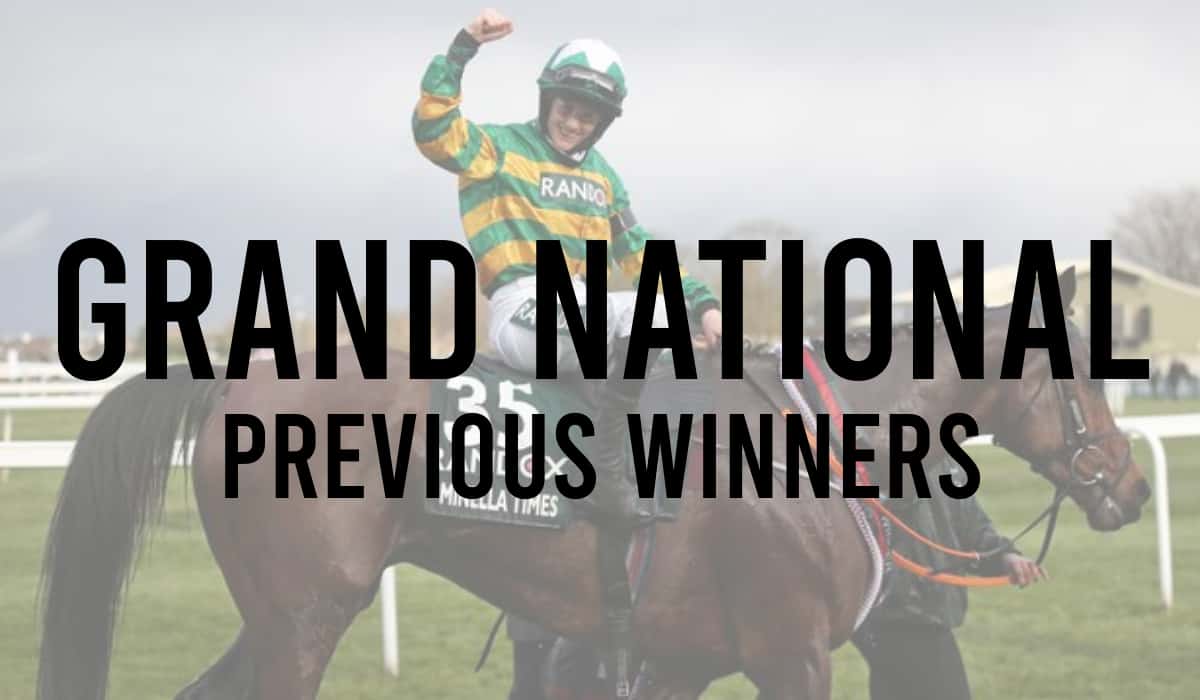The Grand National fences are the most famous jumps in the world and completing the Grand National course is a challenging test for the runners and riders for many reasons.
In our Grand National Course guide, we highlight everything you need to know about the race and why commentators talk about charging toward Becher’s Brook, the most likely obstacle the horses are subject to falling, The Chair fence’s incredible dimensions and where some fences get the names from. We look at The Grand National fences and the unique channels each offer.
We also have a superb Grand National course video so you can get a sense of what is like to ride in the world’s most famous race.
Find out more about the Grand National fences:
Contents
- 1 Our Grand National Course Video
- 2 Grand National Fence Names
- 2.1 1st Grand National Fence
- 2.2 2nd Grand National Fence
- 2.3 3rd Grand National Fence
- 2.4 4th Grand National Fence
- 2.5 5th Grand National Fence
- 2.6 6th Grand National Fence
- 2.7 7th Grand National Fence
- 2.8 8th Grand National Fence
- 2.9 9th Grand National Fence
- 2.10 10th Grand National Fence
- 2.11 11th Grand National Fence
- 2.12 12th Grand National Fence
- 2.13 13th Grand National Fence
- 2.14 14th Grand National Fence
- 2.15 15th Grand National Fence
- 2.16 16th Grand National Fence
- 2.17 17th Grand National Fence
- 2.18 18th Grand National Fence
- 2.19 19th Grand National Fence
- 2.20 20th Grand National Fence
- 2.21 21st Grand National Fence
- 2.22 22nd Grand National Fence
- 2.23 23rd Grand National Fence
- 2.24 24th Grand National Fence
- 2.25 25th Grand National Fence
- 2.26 26th Grand National Fence
- 2.27 27th Grand National Fence
- 2.28 28th Grand National Fence
- 2.29 29th Grand National Fence
- 2.30 30th Grand National Fence
- 3 Grand National Course Map
- 4 Most Famous Grand National Fences
- 5 Popular Questions
- 5.1 Which fences are only jumps once in the Grand National?
- 5.2 How many Grand National fences are jumped twice?
- 5.3 How many fences does the winning horse have to jump in the Grand National?
- 5.4 Have the Grand National fences got smaller?
- 5.5 What is an open ditch Grand National fence?
- 5.6 What are Grand National fences made of?
- 5.7 Who are the previous winners of the Grand National festival?
- 5.8 How to get tickets for Grand National Day?
- 6 Summary of the Grand National Fences
- 7 Related 2024 Grand National Betting Articles
- 8 Keywords Associated With Grand National Fences

Our Grand National Course Video
Have you ever wondered what it would be like to ride the Grand National? If so, check out our amazing flyover 2024 Aintree Grand National Course video guide here:
The grand national course map video explains how many fences are jumped in the grand national and all the 2024 grand national fence names.
Voted the most impressive spectacle in horse racing history the iconic race offers such a challenge for both runners and riders.
Millions watch the famous race and have a flutter on the gee-gees in the hope a long-odds outsider wins the race. Bettors are influenced by some huge grand national betting offers on display for new customers online.
In our Grand National Course guide, we highlight everything you need to know about the race and why commentators talk about charging toward Becher’s Brook, the most likely obstacle the horses are subject to falling, The Chair fence’s incredible dimensions and where some fences get the names from.
Grand National Fence Names
Over the 4 miles, 2-and-a-half furlong Grand National course we will run through all 30 jumps the horses need to take.

- Westhead (fences 3 + 19)
- Bechers Brook (fences 6 + 22)
- Foinavon (fences 7 + 23)
- Canal Turn (fences 8 + 24)
- Valentines Brook (fences 9 + 25)
- Booth (fences 11 + 27)
- The Chair (fence 15)
- Water Jump (fence 16)
In this grand national course map review, we run through all grand national fences in order of being jumped by the 2024 Grand National Runners and Riders.
1st Grand National Fence
The first fence on the Grand National Course is a 4ft 6in high plain fence obstacle.
Although one of the smallest fences on the course as all 40 runners charge to the first fence it is usually packed with horses fighting for positioning.
The first fence marks the start of the Grand National race and is parallel to the Embankment, which has 13,000 racegoers.
Fence number one is a ‘settling’ fence and helps the runners and riders find their stride at the beginning of the race.
2nd Grand National Fence
The second fence on the Grand National Course is a 4ft 7in high plain fence.
3rd Grand National Fence
The third fence on the Grand National Course is a 5ft high open ditch fence obstacle.
The name of fence number 3 in the Grand National is “The Westhead Fence”.
The third fence is named after Steve Westhead, Aintree’s fence builder in the 1960s and ‘70s.
Fence number three is the first open ditch where riders need to see a good stride for the horse.
4th Grand National Fence
The fourth fence on the Grand National Course is a 4ft 10in high plain fence.
5th Grand National Fence
The fifth fence on the Grand National Course is a 5ft high plain fence.
The landing side of the 5th fence was levelled in 2013.
6th Grand National Fence
The sixth fence on the Grand National Course is a 4ft 10in high fence with an additional 10in drop on the landing side.
The name of fence number 6 in the Grand National is “Bechers Brook”.
The 6th fence has caught many Grand National runners out because of the drop on the landing side of the fence.
The fence is called Becher’s Brook after jockey Captain Martin Becher who was thrown off his horse, Conrad, while leading the 1839 Grand National.
Jockeys need to be brave and sit back, so their body weight stabilises the horse as they make this jump and is voted one of the most challenging jumps on the aintree grand national course map.
7th Grand National Fence
The seventh fence on the Grand National Course is a 4ft 6in high plain fence.
The name of fence number 7 in the Grand National is “Foinavon Fence”.
The 7th fence (Foinavon) is actually jumped twice and the name of the fence is after the mass pile-up in the 1967 Grand National that resulted in Foinavon winning the race at a staggering 100-1 price. The pile-up happened on the second circuit so was the 23rd fence of the race. Foinavon was the only horse to jump the fence on his first attempt.
There’s a lot of Grand National history involved with many of the fences that are in place.
8th Grand National Fence
The eighth fence on the Grand National Course is a 5ft high plain fence obstacle.
The name of fence number 8 in the Grand National is “The Canal Turn Fence”.
The 8th fence is the tightest corner of the Grand National racecourse and requires an immediate left-hand turn once over the fence.
Fence number eight is called the Canal Turn from the Leeds-Liverpool canal that runs alongside the far west corner of the course.
9th Grand National Fence
The ninth fence on the Grand National Course is a 5ft high plain fence.
The name of fence number 9 in the Grand National is “Valentines Brook Fence”.
The ninth fence is called Valentine’s Brook and gets its name from the 1840 Grand National where horse Valentine supposedly vaulted it almost sideways to land hind legs first. The first hind legs was jumped for the first time in 1840.
10th Grand National Fence
The tenth fence on the Grand National Course is a 5ft high plain fence.
11th Grand National Fence
The eleventh fence on the Grand National Course is a 5ft high open ditch fence.
The name of fence number 11 in the Grand National festival is “Booth Fence”.
The 11th fence is called the Booth after an Aintree fence builder, John Booth.
This is the fence where red-hot favourite, Golden Miller fell after refusing to jump in the 1935 Grand National race.
He won in record time in the previous year, 1934, and became the first horse to win the Cheltenham Gold Cup and Grand National race in the same season.
12th Grand National Fence
The twelve fence on the Grand National Course is a 5ft high plain fence.
13th Grand National Fence
The 13th fence on the Grand National meeting is a 4ft 7in high plain fence.
14th Grand National Fence
The 14th fence on the Grand National Course is a 4ft 6in high plain fence obstacle.
15th Grand National Fence
The 15th fence on the Grand National Course is a 5ft 2in high open ditch fence with an additional drop on the landing side.
The name of fence number 15 in the Grand National is “The Chair Fence”.
The Chair fence is the most notorious at Aintree Racecourse and is considered the most challenging jump by jockeys.
The hardest of all the Grand National fences it stands at least 2in higher than any other jump and the open ditch behind means a horse must spread 11ft to clear it.
The name comes from a practice in the 19th century during heats where a judge would sit at the fence and use it as a Chair. While sitting at the fence the judge would disqualify horses who hadn’t reached it by the time a heat winner was declared. Failing to reach The Chair meant you could not advance to the next heat.
The 15th jump is one of the most difficult fences to get over and of all the spruce-covered obstacles that are the Grand National fences have the most fallers.
The Chair is the tallest and broadest obstacle for horses to negotiate this jump is not for the faint hearted.
16th Grand National Fence
The 16th fence on the Grand National Course is a 2ft 6in high fence with a water pond behind.
The name of fence number 16 in the Grand National is “The Water Jump Fence”.
After the chair this small 2ft 6in high fence is easy for jumping over but has a larger pool of water behind that requires horses to spread 12ft 6in in order to clear the entire jump.
17th Grand National Fence
The 17th fence on the Grand National Course is a 4ft 6in high plain fence.
The 17th fence is a width of 2ft 9in and is one of the smallest jumps on the Grand National course.
18th Grand National Fence
The 18th fence on the Grand National Course is a 4ft 7in high plain fence.
The 18th fence is a width of 3ft 6in so starting to test the runners jumping skills.
19th Grand National Fence
The 19th fence on the Grand National Course is a 5ft high open ditch fence.
The name of fence number 19 in the Grand National is “The Westhead Fence”.
At 5ft high, it is also known as ‘Westhead’ after the late Steve Westhead who was one of Aintree’s fence builders and worked at Aintree Racecourse in the 1970s.
20th Grand National Fence
The 20th fence on the Grand National Course is a 4ft 10in high plain fence.
21st Grand National Fence
The 21st fence on the Grand National Course is a 5ft high plain fence.
The landing side of the 21st fence was levelled in 2013.
22nd Grand National Fence
The 22nd fence on the Grand National Course is a 4ft 10in high famous fence with an additional 10in drop on the landing side.
The name of fence number 22 in the Grand National is “Bechers Brook”.
The 22nd fence has caught many Grand National runners out because of the drop on the landing side of the fence.
This Becher’s Brook fence has been remodelled several times, with the drop on the landing side levelled in the 1990s and again after the 2011 Grand National race. The famous fence was named after Captain Martin Becher who jumped the fence but was unseated.
23rd Grand National Fence
The 23rd fence on the Grand National Course is a 4ft 6in high plain fence.
The name of fence number 23 in the Grand National is “Foinavon Fence”.
The 23rd fence is famous for a mass pile-up in the 1967 Grand National that resulted in Foinavon winning the race at a staggering 100-1 price.
24th Grand National Fence
The 24th fence on the Grand National Course is a 5ft high plain fence.
The name of fence number 24 in the Grand National is “The Canal Turn Fence”.
The 24th fence is the tightest corner of the Grand National racecourse and requires an immediate left-hand turn once over the fence.
Fence number 24 is called the Canal Turn from the Leeds-Liverpool canal that runs alongside the far west corner of the course.
Fence number 24 of the Grand National jumps course is where the track pretty much makes a right angle and if horses didn’t turn the 90 degrees early they would end up in the Leeds-Liverpool Canal so you can see where the Canal Turn name came from.
25th Grand National Fence
The 25th fence on the Grand National Course is a 5ft high plain fence.
The name of fence number 25 in the Grand National is “Valentines Brook Fence”.
The 25th fence is called Valentine’s Brook and gets its name from the 1840 Grand National where horse Valentine supposedly vaulted it almost sideways to land hind legs first.
26th Grand National Fence
The tenth fence on the Grand National Course is a 5ft high plain fence.
27th Grand National Fence
The 27th fence on the Grand National Course is a 5ft high open ditch fence.
The name of fence number 27 in the Grand National is “Booth Fence”.
The 27th fence is called the Booth after an Aintree fence builder, John Booth.
28th Grand National Fence
The 28th fence on the Grand National Course is a 5ft high plain fence obstacle.
29th Grand National Fence
The 29th fence on the Grand National Course is a 4ft 7in high plain fence obstacle.
It is the second last turning from home and the race is starting to unfold.
30th Grand National Fence
The 30th fence is the final fence on the Grand National Course is a 4ft 6in high plain fence.
The last and final flight and coming up the home straight the race to the winning line is within sight.
Grand National Course Map
The Grand National course is run over two complete circuits with 16 flights to jump on the first circuit and 14 flights to jump on the second circuit.
The Aintree course is triangular in shape and consists of 30 jumps over 4 miles, 2 ½ furlongs trip.
The famous run-in is 494 yards long and includes an elbow finish.
Most Famous Grand National Fences
Becher’s Brook, Valentines’ Brook, The Chair, Canal Turn and Foinavon are names that are all part of the heritage of the Grand National.
Here are the most famous fences on the Grand National Course.
Becher’s Brook
Captain Martin Becher is one of the Grand National’s most famous jockeys and Becher’s Brook is named after him
Becher’s Brook is the 6th and 22nd fence in the Grand National.
Becher fell at the flight and hid in the brook to avoid injury from other runners jumping the fence.
Jockeys have compared it to “jumping off the edge of the world” due to the fact that the landing side of the fence is 10 inches lower than the take-off side.
Valentines’ Brook
Valentine’s Brook is the 9th and 25th fence in the Grand National.
The Chair
The Chair is the tallest fence (5ft 2in) in the Grand National and horses must also clear a 6ft ditch on the take-off side.
The fence was originally known as the Monument Jump.
The Chair is the 15th fence in the Grand National and is only jumped once.
Canal Turn
The Canal Turn fence is almost 90 degrees switch in direction and horses unseating the jockey is common as jockeys become unbalanced as they change course.
The Canal Turn is notable for the sharp left turn that the runners have to take as soon as they have negotiated the fence.
The Canal Turn is the 8th and 24th fence in the Grand National.
The Foinavon fence was re-named in 1984 after the 100-1 outsider who avoided a mass pile-up here in 1967 and went on to win the race.
The fence is just 4ft 6in and is one of the smaller fences in the Grand National, the only fence smaller is the Water Jump.
Foinavon is the 7th and 23rd fence in the Grand National.
Popular Questions
Which fences are only jumps once in the Grand National?
The fences in the Grand National only jumped once are:
- The Chair fence
- The Water Jump fence
There are 16 obstacles on the Grand National course on the first lap with the Chair and Water Jump being the last two fences on the first circuit.
But on the second lap only 14 fences are jumped and the Chair and Water Jump are not jumped twice with only 30 jumps in total.
How many Grand National fences are jumped twice?
14 of the 16 fences on the Grand National course are jumped twice.
The four-mile, two and a half furlong distance consists of 30 jumps in total.
On the second circuit only 14 jumps are completed with the Chair and Water Jump is not jumped on the 2nd lap.
How many fences does the winning horse have to jump in the Grand National?
The winning horse has to jump 30 fences in total in the Grand National.
The 30 jumps carried out by the winning horse cover over 4 miles with horses needing to complete two laps of the course.
Have the Grand National fences got smaller?
Some of the Grand National fences have gotten smaller on the landing side of the fences.
Many Grand National folk of old say “It is not what it used to be in our day” with tweaks made to Aintree’s infamous chase.
Many have been officially tweaked for the safety and well-being of the runners and riders with Becher’s Brook the most noticeable being smaller on the landing side of the jump.
What is an open ditch Grand National fence?
An open ditch in Grand National is a plain fence with a ditch on the take-off side.
The ditch before the fence forces the Grand National runners to make a longer jump than at a plain fence.
What are Grand National fences made of?
Horse racing fences in the Grand National are made of Sitka or Norway spruce, which is brought down from the Lake District, and it is weaved into a plastic birch structure which provides flexibility should a runner make a mistake at the jump.
The old Grand National fences used to be constructed from natural thorn hedges and were known as ‘thorn fences’. But for the health and safety of the runners and riders, they designed the newer jumps to provide more flexibility.
With the exception of a water jump, all steeplechase fences must be a minimum of 4′ 6” in height.
Who are the previous winners of the Grand National festival?
In 2021, Rachael Blackmore won the Grand National festival with Minella Times. You can find all of the previous Grand National winners with our full breakdown.
How to get tickets for Grand National Day?
You can buy tickets for Thursday, Friday or Saturday. The three-day event hosts a tens of thousands of spectators. Get your Grand National tickets for the Grand National Day using our guide.
Summary of the Grand National Fences
The Grand National Fences on the Aintree Racecourse are famous globally with millions of horse racing fans all over the world watching the race live.
The heritage and history of the Grand National are what makes the racing event the pinnacle of National Hunt racing.
Jumping all the Grand National jumps and staying the extended 4m 2f trip remains the ultimate stamina test for National Hunt thoroughbred horses.
Our fence-by-fence Aintree racecourse map highlights which obstacles consistently claim victims and are voted the hardest fence to get over in April 2024. The history of the iconic race and the uniqueness of the spruce-covered fence obstacles is what makes the Grand National fences and racing event so special for horse racing fans.
Here are all the related articles to the Randox Grand National 2024.
- Aintree Festival

- Aintree Festival Day 1 Tips

- Aintree Festival Day 2 Tips

- Aintree Festival Day 3 Tips

- Aintree Foxhunters Chase

- Aintree Hurdle

- Aintree Racecourse

- Anniversary 4-Y-O Novices’ Hurdle

- Bet On Grand National Online

- Grand National 2024

- Grand National Betting Odds

- Grand National Betting Promotions

- Grand National Dark Horses

- Grand National Facts

- Grand National Fallers

- Grand National Favourites

- Grand National Fences

- Grand National Previous Winners

- Grand National Prize Money

- Grand National Runners

- Grand National Start Times

- Grand National Tickets

- Grand National Tips

- Grand National Weights

- Grey Horses in the Grand National

- How Many Places Pay Out in Grand National?

- Liverpool Hurdle

- Maghull Novices’ Chase

- Manifesto Novices’ Chase

- Melling Chase

- Mersey Novices’ Hurdle

- Mildmay Novices Chase

- Nickel Coin Mares’ Standard Open NH Flat Race

- Red Rum Handicap Chase

- Sefton Novices Hurdle

- Top Novices’ Hurdle

- Topham Chase

- Watch the Grand National Live

If you do choose to bet, please bet responsibly.
Keywords Associated With Grand National Fences
- Grand National Beechers Brook
- Beachers Brook fence
- Fences in grand national
- Grand National course preview
- Grand National course guide 2024